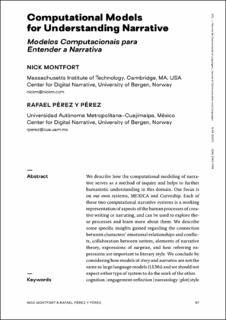| dc.contributor.author | Montfort, Nicholas | |
| dc.contributor.author | Perez Y Perez, Rafael | |
| dc.date.accessioned | 2024-02-14T13:56:18Z | |
| dc.date.available | 2024-02-14T13:56:18Z | |
| dc.date.created | 2023-12-08T08:52:15Z | |
| dc.date.issued | 2023 | |
| dc.identifier.issn | 2183-7198 | |
| dc.identifier.uri | https://hdl.handle.net/11250/3117603 | |
| dc.description.abstract | We describe how the computational modeling of narrative serves as a method of inquiry and helps to further humanistic understanding in this domain. Our focus is on our own systems, MEXICA and Curveship. Each of these two computational narrative systems is a working representation of aspects of the human processes of creative writing or narrating, and can be used to explore these processes and learn more about them. We describe some specific insights gained regarding the connection between characters’ emotional relationships and conflicts, collaboration between writers, elements of narrative theory, expressions of surprise, and how referring expressions are important to literary style. We conclude by considering how models of story and narrative are not the same as large language models (LLMs) and we should not expect either type of system to do the work of the other. | en_US |
| dc.language.iso | eng | en_US |
| dc.relation.uri | https://rcl.fcsh.unl.pt/index.php/rcl/article/view/247 | |
| dc.rights | Navngivelse-Ikkekommersiell 4.0 Internasjonal | * |
| dc.rights.uri | http://creativecommons.org/licenses/by-nc/4.0/deed.no | * |
| dc.title | Computational Models for Understanding Narrative | en_US |
| dc.type | Journal article | en_US |
| dc.description.version | publishedVersion | en_US |
| cristin.ispublished | true | |
| cristin.fulltext | original | |
| dc.identifier.doi | https://doi.org/10.34619/gnzq-r7ri | |
| dc.identifier.cristin | 2210749 | |
| dc.source.journal | Revista de Comunicação e Linguagens | en_US |
| dc.source.pagenumber | 97-117 | en_US |
| dc.relation.project | Norges forskningsråd: 332643 | en_US |
| dc.identifier.citation | Revista de Comunicação e Linguagens. 2023, 58, 97-117. | en_US |
| dc.source.volume | 58 | en_US |

